If you’re looking for the BEST curry powder recipe, look no further! The flavor and aroma of this curry blend is an absolute feast for the senses and hands down beats anything you’ll find at the grocery store!
For more homemade Indian spice blends be sure to try our Garam Masala, Chaat Masala, and Panch Phoron!
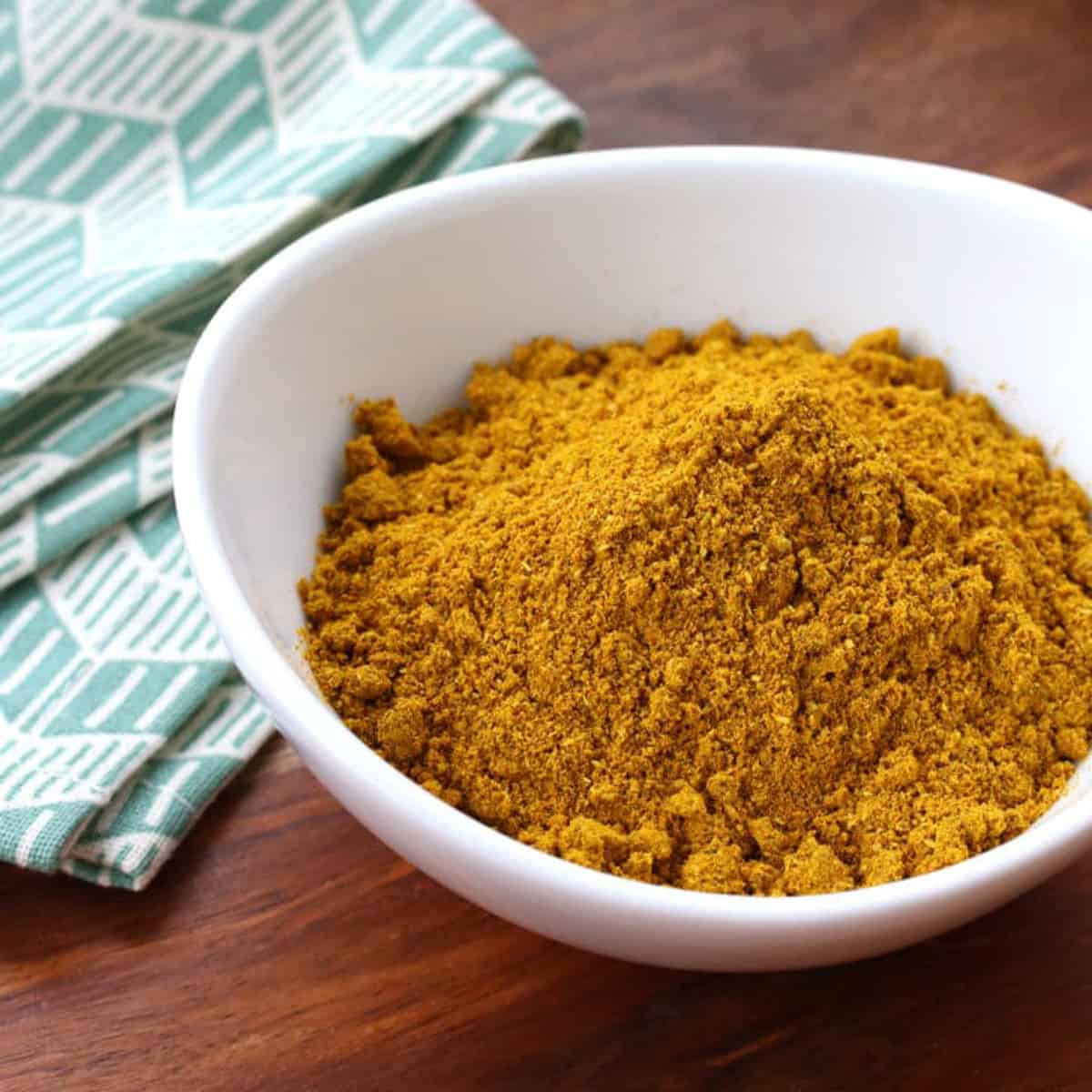
Growing up my mom made Indian food on a regular basis and the smell of cardamom, coriander, fennel and other spices wafting from the kitchen was a sure way to whet our appetites. Here’s a recipe for homemade curry powder, a versatile spice blend you can use in a whole host of Indian-inspired dishes. This curry powder recipe is the ultimate blend of carefully balanced spices that will deliver flavor and fragrance to your food!
Where Did Curry Powder Originate?
You may think the answer is obvious: “Duh. India.” But you may be surprised to know that curry powder doesn’t exist on the Indian subcontinent and is in fact an 18th century British invention.
Whereas most Indian recipes use a variety of different individual spices, curry powder was Great Britain’s way of simplifying Indian cooking in a way that was easily accessible to the British home cook who would otherwise have found it difficult to acquire some of these spices. British manufacturers developed a pre-made blend of Indian spices, called it “curry powder”, and sold it in tin cans (popular brands that still exist include Sharwood’s, The Original Ship/Green Label and Crosse & Blackwell). Now cooks could take out a scoop or two of “curry powder,” add it to their meal, and enjoy a full array of Indian flavors.
It was during this same time period that British cookbooks started including recipes for “curry sauce,” another British creation. The term “curry” is the anglicized version of the Tamil word kari, which translates to the generic word “sauce.” In Great Britain, “curry sauce” referred to a specific dish that used curry powder. And this “curry sauce” has since become world renowned and conjures up an immediate recognition and expectation of what it will taste like.
Curry Powder Ingredients
There is no standard recipe and both the selection of spices and their ratios vary from recipe to recipe and from brand to brand. However there are several spices that more often than not are included in curry powder and those include coriander, cumin, turmeric, cinnamon, ginger, fenugreek, fennel, curry leaf or bay leaf, garlic, black pepper and red chilies. Cardamom is sometimes included though less commonly. The cardamom flavor is featured more commonly in Garam Masala. For spicy-hot curry, more red chilies and yellow mustard seeds are added.
These spices can be added in any number of different ratios which will give more emphasis to one flavor over the other. My goal in developing this curry powder recipe was to create a good balance of all the flavors, each one complementing rather than rivaling the other. And I also wanted to replicate the flavor of my favorite British curry powder brands that I came to love during the years I lived in England. This carefully crafted blend will give your food a remarkable depth and complexity of flavor and we’re confident you’re going to love it as much as we do.
Do I Have to Use Whole Spices?
No, but we HIGHLY recommend it. The natural oils in spices is where the flavor is concentrated and these oils are highly perishable once the whole spices have been ground. The pre-ground spices sold in stores have been sitting in jars for a long time and their flavor is bland in comparison to freshly ground spices.
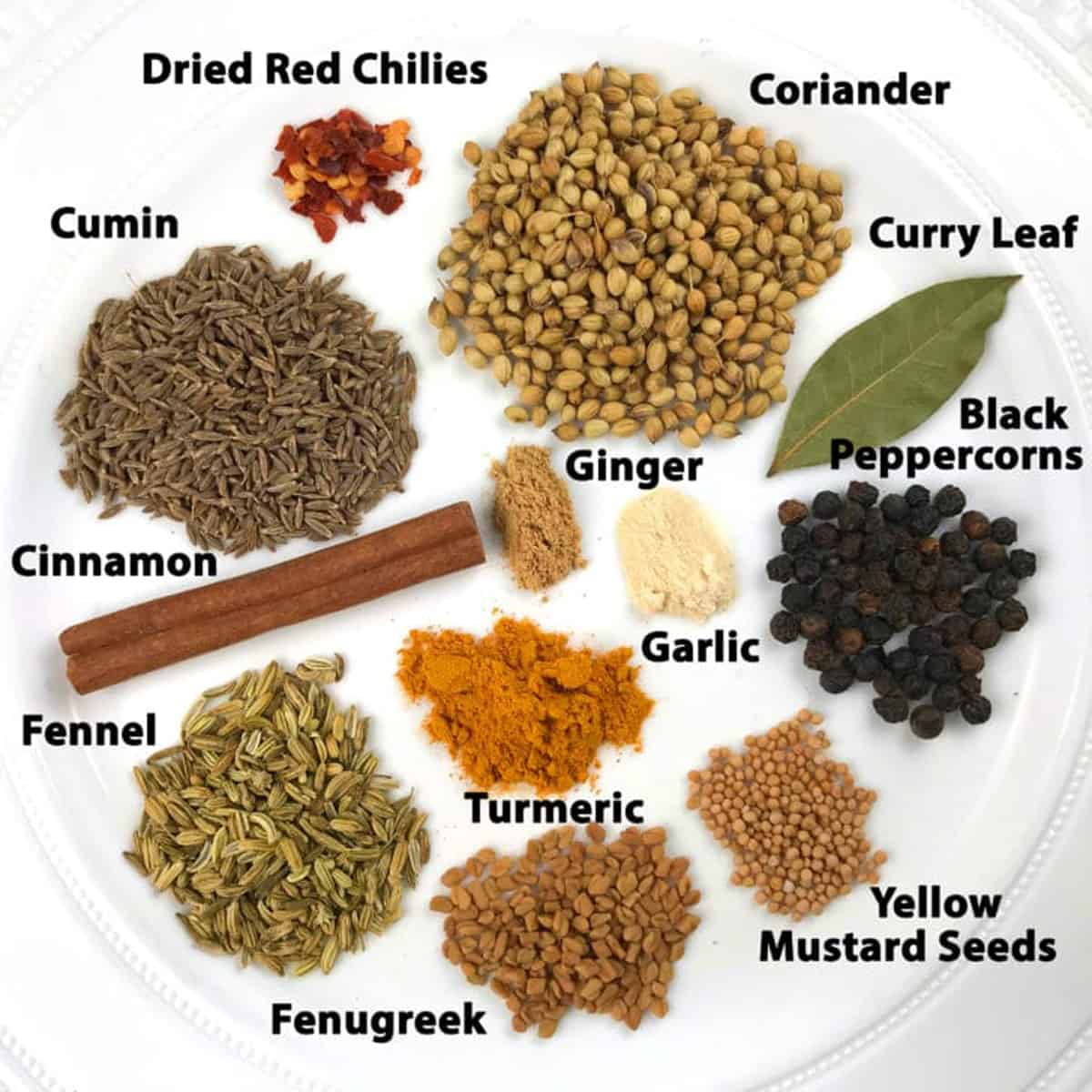
Curry Powder vs. Madras Curry Powder
They both have the same ingredients and thus the same flavor, but they differ in their level of heat. Standard curry powder is milder whereas madras curry powder is hot. This heat come from adding more red chilies as well as yellow mustard seeds. You can easily adapt this recipe to make madras curry powder by adding these two ingredients.
How Long Does This Keep?
Because the natural oils in the whole spices perish fairly quickly one the spices are ground we always recommend making seasoning blends in small batches so that you can use them up quickly. While this blend will keep for several months (and still taste better than store-bought) the flavor potency will weaken over time, so for maximum flavor it’s best to use it within a few weeks.
Curry Powder Recipe
Making your own couldn’t be any simpler. The only remotely challenging part may be finding the needed spices. But I’ve provided links in the recipe box to where you can conveniently find them on Amazon if you can’t find them locally. Once you have all the spices all you have to do is dry-roast the whole spices in a skillet and then grind the cooled spices together with the remaining spices.
Let’s get started!
Heat a skillet over medium heat and roast the whole spices and curry/bay leaves for a few minutes until very fragrant. Be careful not to scorch the spices or they will be bitter. Let the spices cool completely.
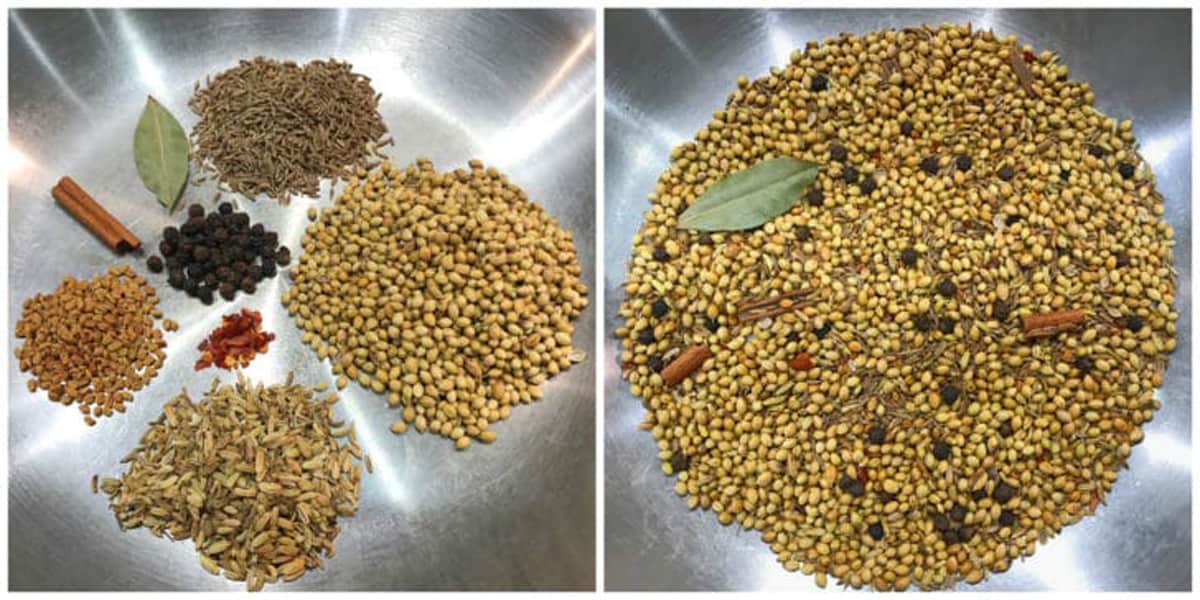
Once completely cool, place the toasted whole spices in a spice/coffee grinder along with the remaining ingredients and grind until you get a fine powder.
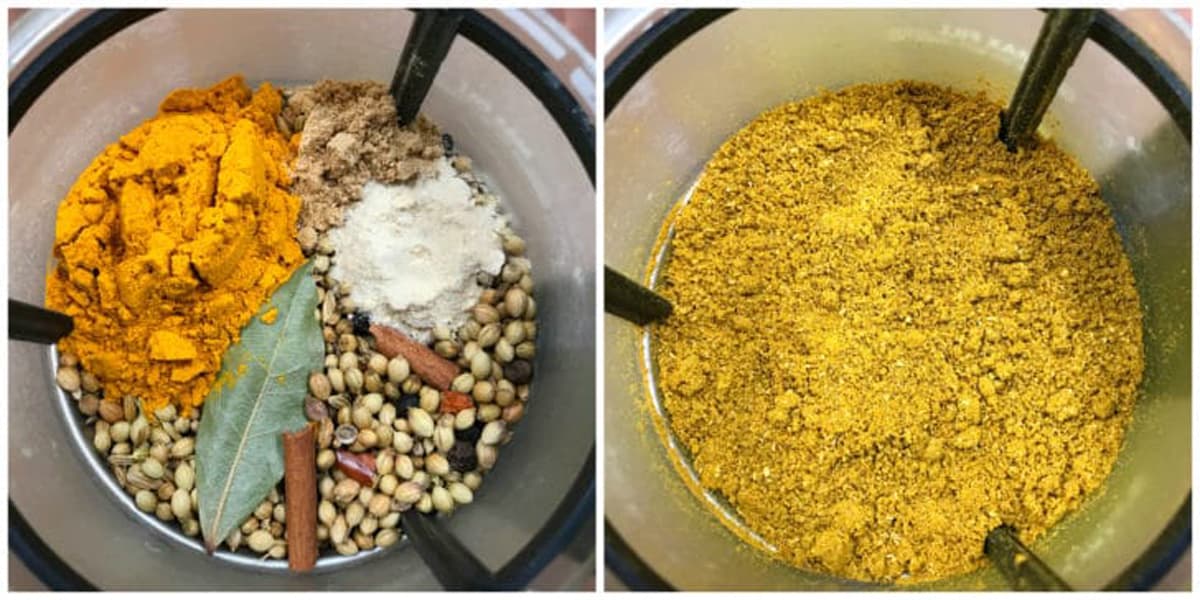
Store the spice blend in an airtight jar in a dark, cool place. Will keep for several months but for best flavor use within a few weeks.
Enjoy!
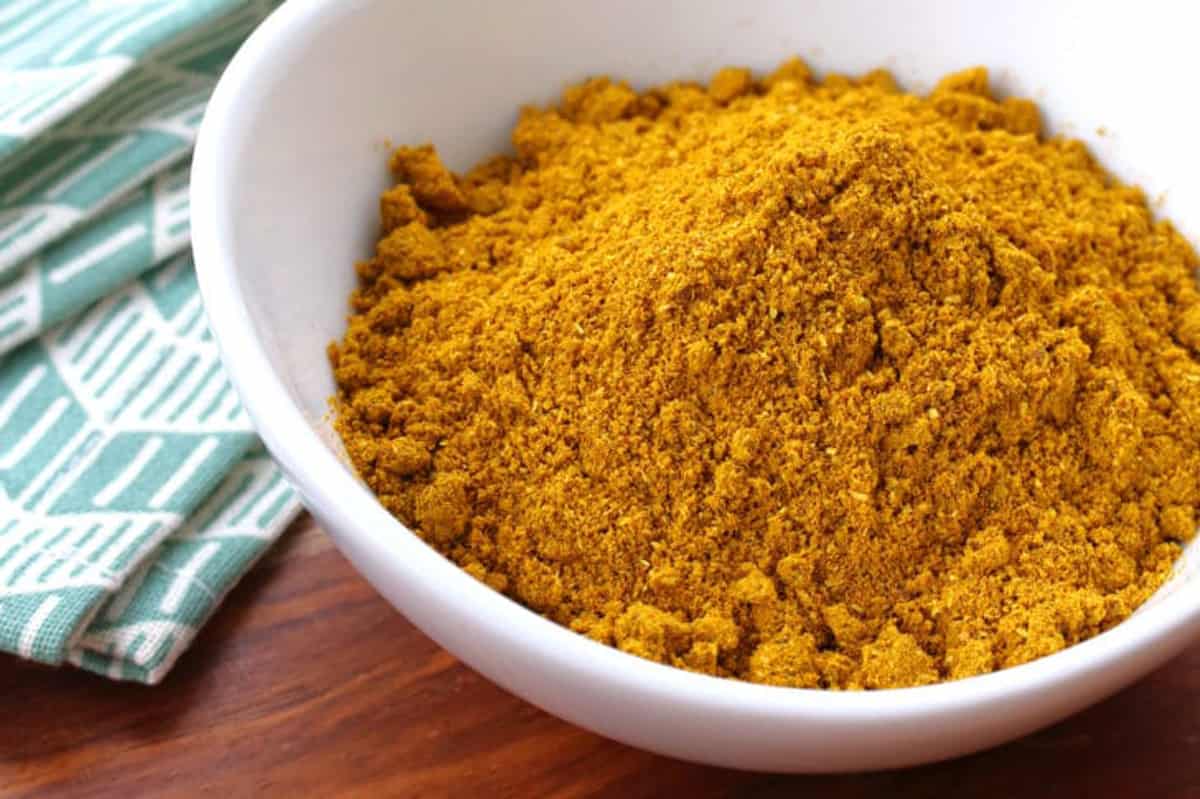
Watch How Its Made
For more delicious homemade seasoning blends be sure to try our:
- Greek Seasoning
- Old Bay Seasoning
- Creole Seasoning
- Montreal Steak Seasoning
- Poultry Seasoning
- Dukkah
- Za’atar
- Chinese Five Spice
- Chili Powder
- British Mixed Spice
- Porcini Salt
- Pot Roast Seasoning
- Berbere
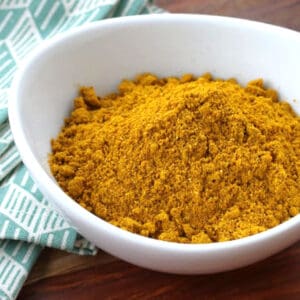
BEST Curry Powder
Ingredients
- 1/4 cup coriander seeds
- 4 teaspoons cumin seeds
- 1 tablespoon fennel seeds
- 1 teaspoon fenugreek seeds
- 1 teaspoon black peppercorns
- 1 teaspoon yellow mustard seeds (optional, for added heat)
- 4 small dried red chili peppers
- 4 dried curry leaves (can substitute 1 large bay leaf)
- 2 tablespoons ground turmeric
- 1/2 teaspoon ground ginger
- 1/2 teaspoon garlic powder
- 1/2 teaspoon salt
- 1/4 teaspoon ground cinnamon
Instructions
- Heat a skillet over medium heat and roast the whole spices and curry/bay leaves for a few minutes until very fragrant. Be careful not to scorch the spices or they will be bitter. Let the spices cool completely. Place the whole spices in a spice/coffee grinder along with the remaining ingredients and grind until you get a fine powder. Store the curry powder in an airtight jar in a dark, cool place. Will keep for several months but for best flavor use within a few weeks. Makes approx. 1/2 cup of curry powder.
- To Make Curry Paste: Combine 1 tablespoon of curry powder with 1 tablespoon of water and 1 tablespoon of oil and mix together. You can also add some finely minced garlic and ginger. (You can use larger quantities of the paste ingredients and puree everything together in a blender.) For a Thai curry paste replace the water with fish sauce and add a squirt of lime juice.
Nutrition
Originally published on The Daring Gourmet January 28, 2020
Brooke says
I absolutely LOVED this recipe for curry powder. Its so fresh and flavorful. I’m wondering what the measurements for all the whole spice ingredients would be if you used already ground for all of them. I have the whole spices because I cook a lot of Indian food, but for those starting out, maybe they only have ground coriander or cumin….would the measurements be the same for the powder as for the whole spice?
Kimberly Killebrew says
Thank you, Brooke, I’m so glad you enjoyed it! The rule for converting whole spices to ground is generally to use 3/4 ground to 1 whole. So 1 teaspoon of whole coriander seeds would be roughly 3/4 teaspoon ground.
Leslie says
I can’t wait to try this recipe! I do have a question, though. The picture shows a whole cinnamon stick, but the recipe calls for ground cinnamon. I would prefer to use the whole stick and roast it. What is the equivalent size/number of whole sticks to match the amount of ground listed in the recipe, please? Thank you!
Kimberly Killebrew says
Hi Leslie, you’ll need about 1/2 stick of cinnamon or around an inch or so in length. Happy cooking! :)
Jean Sopko says
So many positive comments, I’m going to make this! I’d like to double or triple the recipe, add water and oil as you described to make it into paste, then freeze it so it will stay fresh longer. Your thoughts please?
Kimberly Killebrew says
Hi Jean, yes you can definitely do that. A convenient way to freeze it would be to spoon the paste into an ice cube try, freeze it, and then transfer the cubes into a zip lock freezer bag and you can just grab what you need when you need it.
Michelle H says
I made this because it sounded simple, what I didn’t expect was such a complexity of flavour! By far the best curry I have had in a long time! I just wanted a recipe my parents could easily follow – this far surpassed my expectations! Thank you so much – it is going to be my staple in the kitchen for curries going forwards!
Kimberly Killebrew says
I’m so happy to hear that, Michelle, thank you very much for the feedback!
Gina Bisaillon says
Your a link to the spice grinder is no longer valid but I have been using a $10 spice/coffee grinder for this for years and years and it still works perfectly. What I mean is don’t blow a lot of money on this kind of grinder because they’re all exactly the same.
Carol says
Thank you for walking me through the process. I’m still new in kitchen and get nervous with many recipes as they are bit confusing but yours are great.
Kimberly Killebrew says
Thanks so much, Carol, I’m so glad you enjoyed it!
Jenny says
Curry is one of my favourites! So great for getting me out of my lunch routine with this prep.
Mara says
Flavor is amazing! Great base for many dishes I make. Awesome!
Kimberly Killebrew says
Thank you so much, Mara, I’m happy you enjoyed it!
Miranda says
Hello Kimberly from Sydney Australia,
Thank you for the interesting information and yummy recipes, they never fail to please.
I very much appreciate all the details you add, so helpful.
I do love receiving your mail outs.
Wishing you good health, happiness and success for 2022.
Kimberly @ The Daring Gourmet says
Friendly greetings to you and Sydney, Miranda! Thank you very much for your kind words and wishes and a happy, healthy 2022 to you as well! :)
Colin Davies says
Have used this recipe in weekly curries for over 2 years together with Shashtri garam masala (own blend) in Chicken curry, a very popular dish with friends and family – much much better than store bought.
Kimberly Killebrew says
I am beyond thrilled to hear that, Colin, thank you so much for the feedback! :)
Zeff says
A decent masala/madras curry there.
Your history on curry is also a partial myth.
India has always had spicy food and, the imperial British troops found a use for that. Problem with military meat rations is that it goes off fast in the heat of India. They would use a load of spices, in excess, to hide the slightly rancid taste/smell of the meat as it started to spoil so they could eat it. That was how English curry started. There are also some curries that come from the UK, chicken tikka masala is one of them (first created in Glasgow). “Curry” itself has been around for many centuries in Asia, some of the worlds hottest chilies come from Thailand. They have always had hot food but, nobody makes a mess of a curry quite like an Englishman. Just no concept of balance of flavor, it just tastes of rough spices and nothing else.
Sarfaraz says
Curry as we know it started because of the spice trade, not English military rations, but economics. Traditional English curry like Japanese curry are often roix based which is why they resemble each other, think coronation chicken or the curry sauce served with fish and chips.
Later immigrants brought recipes that they tailored for both the native palate but also their own: Indians, Pakistais, Bangladeshis, Sri Lankans, but also the Kenyan and Ugandan Asians with their coconut based curries. That’s just the S. Asians.
As a country of immigrants the English enjoy some of best curries in the world that match India for standards, and surpass it for diversity and innovation.
Tony says
Well, I came to add my tuppence but you’ve already addressed Zeff far more eloquently than I could have.
I’ve had the fortune of eating all over the globe, and I can confidently day that the right place in England can absolutely produce spectacular curries, that easily rival their countries’ of influence.
As for the recipe, it makes a wonderful base for the home cook, even if we do apparently make a mess of it ;-)
Joseph Paulk says
FANTASTIC RECIPE! Thank-you so much for sharing it.
Kimberly @ The Daring Gourmet says
Thanks so much, Joseph, I’m happy you enjoyed it!
Anagor Ada says
Thanks so much for this recipe,I totally enjoyed reading and sure will practicalise it.I want you to mentor me on different spice recipe.I currently do few and want to learn from you.
Thanks and warm regards
maiyadi says
This is the best blend of flavors around! please need to know measurements for large quantity
Kimberly @ The Daring Gourmet says
Thank you so much, Maiyadi, I’m so glad you enjoyed it! To increase the quantity, to the right of the ingredients list you’ll see 1X, 2X, 3X that you can click on to double or triple the recipe.
David says
This basic recipe is easy and delicious. The freshly roasted seeds make a great difference in the flavor. I make my own curries and seasoning blends. This one has been moved to the front of the line in my curry file. No recipe is carved in stone, however, this curry is a matter of personal preference and a great building block to begin with. Thanks for sharing.
Kimberly Killebrew says
Thanks so much for the feedback, David, I’m happy you enjoyed it!